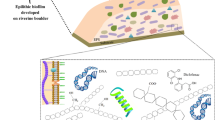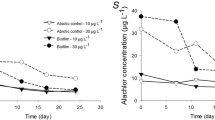Abstract
Due to the high importance of biofilms on river ecosystems, assessment of pesticides’ adverse effects is necessary but is impaired by high variability and poor reproducibility of both natural biofilms and those developed in the laboratory. We constructed a model biofilm to evaluate the effects of pesticides, consisting in cultured microbial strains, Pedobacter sp. 7-11, Aquaspirillum sp. T-5, Stenotrophomonas sp. 3-7, Achnanthes minutissima N71, Nitzschia palea N489, and/or Cyclotella meneghiniana N803. Microbial cell numbers, esterase activity, chlorophyll-a content, and the community structure of the model biofilm were examined and found to be useful as biological factors for evaluating the pesticide effects. The model biofilm was formed through the cooperative interaction of bacteria and diatoms, and a preliminary experiment using the herbicide atrazine, which inhibits diatom growth, indicated that the adverse effect on diatoms inhibited indirectly the bacterial growth and activity and, thus, the formation of the model biofilm. Toxicological tests using model biofilms could be useful for evaluating the pesticide effects and complementary to studies on actual river biofilms.






Similar content being viewed by others
References
Aizaki M (1978) Seasonal changes in standing crop and production of periphyton in the Tamagawa river. Jpn J Ecol 28:123–134
Aizaki M (1980) Changes in standing crop and photosynthetic rate attendant on the film development of periphyton in a shallow eutrophic river. Jpn J Limnol 41:225–234
Araya R, Tani K, Takagi T, Yamaguchi N, Nasu M (2003a) Bacterial activity and community composition in stream water and biofilm from an urban river determined by fluorescent in situ hybridization and DGGE analysis. FEMS Microbiol Ecol 43:111–119
Araya R, Yamaguchi N, Tani K, Nasu M (2003b) Change in the bacterial community of natural river biofilm during biodegradation of aniline-derived compounds determined by denaturing gradient gel electrophoresis. J Health Sci 49:379–385
Avendaño-Herrera RE, Riquelme CE (2007) Production of a diatom–bacteria biofilm in a photobioreactor for aquaculture applications. Aquacult Eng 36:97–104
Battin TJ (1997) Assessment of fluorescein diacetate hydrolysis as a measure of total esterase activity in natural stream sediment biofilms. Sci Total Environ 198:51–60
Battin TJ, Kaplan LA, Newbold JD, Hansen CME (2003) Contributions of microbial biofilms to ecosystem processes in stream mesocosms. Nature 426:439–442
Beier S, Witzel KP, Marxsen J (2008) Bacterial community composition in central European running waters examined by temperature gradient gel electrophoresis and sequence analysis of 16S rRNA genes. Appl Environ Microbiol 74:188–199
Besemer K, Singer G, Limberger R, Chlup AK, Hochedlinger G, Hödl I, Baranyi C, Battin TJ (2007) Biophysical controls on community succession in stream biofilms. Appl Environ Microbiol 73:4966–4974
Bohuss I, Rékasi T, Szikora S, Barkács K, Záray G, Ács É (2005) Interaction of acetochlor and atrazine with natural freshwater biofilms grown on polycarbonate substrate in lake Velence (Hungary). Microchem J 79:201–205
Brümmer IHM, Fehr W, Wagner-Döbler I (2000) Biofilm community structure in polluted rivers: abundance of dominant phylogenetic groups over a complete annual cycle. Appl Environ Microbiol 66:3078–3082
Castonguay MH, Schaaf S, Koester W, Krooneman J, Meer W, Harmsen H, Landini P (2006) Biofilm formation by Escherichia coli is stimulated by synergistic interactions and co-adhesion mechanisms with adherence-proficient bacteria. Res Microbiol 157:471–478
Chénier MR, Beaumier D, Roy R, Driscoll BT, Lawrence JR, Greer CW (2003) Impact of seasonal variations and nutrient inputs on nitrogen cycling and degradation of hexadecane by replicated river biofilms. Appl Environ Microbiol 69:5170–5177
Costerton JW, Cheng K-J, Geesey GG, Ladd TL, Nickel JC, Dasgupha M, Marrie TJ (1987) Bacterial biofilms in nature and disease. Annu Rev Microbiol 41:435–464
Davies DG, Geesey GG (1995) Regulation of the alginate biosynthesis gene algC in Pseudomonas aeruginosa during biofilm development in continuous culture. Appl Environ Microbiol 61:860–867
Dorigo U, Leboulanger C, Berard A, Bouchez A, Humbert JF, Montuelle B (2007) Lotic biofilm community structure and pesticide tolerance along a contamination gradient in a vineyard area. Aquat Microb Ecol 50:91–102
Dorigo U, Lefranc C, Leboulanger C, Montuelle B, Humbert JF (2009) Spatial heterogeneity of periphytic microbial communities in a small pesticide-polluted river. FEMS Microbiol Ecol 67:491–501
Duong TT, Morin S, Coste M, Herlory O, Feurtet-Mazel A, Boudou A (2010) Experimental toxicity and bioaccumulation of cadmium in freshwater periphytic diatoms in relation with biofilm maturity. Sci Total Environ 408:552–562
Grossart HP, Levold F, Allgaier M, Simon M, Brinkhoff T (2005) Marine diatom species harbour distinct bacterial communities. Environ Microbiol 7:860–873
Guasch H, Muñoz I, Rosés N, Sabater S (1997) Changes in atrazine toxicity throughout succession of stream periphyton communities. J Appl Phycol 9:137–146
Guasch H, Ivorra N, Lehmann V, Paulsson M, Real M, Sabater S (1998) Community composition and sensitivity of periphyton to atrazine in flowing waters: the role of environmental factors. J Appl Phycol 10:203–213
Hannen EJ, Mooij W, Agterveld MP, Gons HJ, Laanbroek HJ (1999) Detritus-dependent development of the microbial community in an experimental system: qualitative analysis by denaturing gradient gel electrophoresis. Appl Environ Microbiol 65:2478–2484
Hatakeyama S, Fukushima S, Kasai F, Shiraishi H (1994) Assessment of herbicide effects on algal production in the Kokai River (Japan) using a model stream and Selenastrum bioassay. Ecotoxicology 3:143–156
Huong NL, Itoh K, Suyama K (2007) Diversity of 2, 4-dichlorophenoxyacetic acid (2, 4-D) and 2, 4, 5-trichlorophenoxyacetic acid (2, 4, 5-T)-degrading bacteria in Vietnamese soils. Microb Environ 22:243–256
Huong NL, Itoh K, Suyama K (2008) 2, 4-Dichlorophenoxyacetic acid (2, 4-D)- and 2, 4, 5-trichlorophenoxyacetic acid (2, 4, 5-T)-degrading bacterial community in soil-water suspension during the enrichment process. Microb Environ 23:142–148
Ka JO, Holben WE, Tiedje JM (1994) Genetic and phenotypic diversity of 2, 4-dichlorophenoxyacetic acid (2, 4-D)-degrading bacteria isolated from 2, 4-D-treated field soils. Appl Environ Microbiol 60:1106–1115
Lane DJ, Pace B, Olsen GJ, Stahl DA, Sogin ML, Pace NR (1985) Rapid determination of 16S ribosomal RNA sequence for phylogenetic analyses. Proc Natl Acad Sci USA 82:6955–6959
Lock MA (1993) Attached microbial communities in rivers. In: Ford TE (ed) Aquatic microbiology: an ecological approach. Blackwell, Oxford, pp 113–138
Lyautey E, Lacoste B, Ten-Hage L, Rols J-L, Garabetian F (2005) Analysis of bacterial diversity in river biofilms using 16S rDNA PCR-DGGE: methodological settings and fingerprints interpretation. Water Res 39:380–388
Makk J, Ács É, Márialigeti K, Kovács G (2003) Investigations on the Danube gravel–biofilm diatom-associated bacterial communities. Biol Bratislava 58:729–742
Manz W, Szewzyk U, Ericsson P, Amann R, Schleifer KH, Stenstrom TA (1993) In situ identification of bacteria in drinking water and adjoining biofilms by hybridization with 16S and 23S rRNA-directed fluorescent oligonucleotide probes. Appl Environ Microbiol 59:2293–2298
Manz W, Wendt-Potthoff K, Neu TR, Szewzyk U, Lawrence JR (1999) Phylogenetic composition, spatial structure, and dynamics of lotic bacterial biofilms investigated by fluorescent in situ hybridization and confocal laser scanning microscopy. Microb Ecol 37:225–237
Meyer JL (1994) The microbial loop in flowing waters. Microb Ecol 28:195–199
Morikawa K (1984) Seasonal fluctuation in the number of aerobic heterotrophic bacteria and its relation to environmental factors in the upstream area of the Tamagawa river. Jap J Limnol 45:69–78
Morin S, Bottin M, Mazzella N, Macary F, Delmas F, Winterton P, Coste M (2009) Linking diatom community structure to pesticide input as evaluated through spatial contamination potential (Phytopixal): a case study in the Neste river system (South-West France). Aquat Toxicol 94:28–39
Muñoz I, Real M, Guasch H, Navarro E, Sabater S (2001) Effects of atrazine on periphyton under grazing pressure. Aquat Toxicol 55:239–249
Muyzer G, Waal EC, Uitterliden AG (1993) Profiling of complex microbial populations by denaturing gradient gel electrophoresis analysis of PCR-amplified gene coding for 16S rRNA. Appl Environ Microbiol 59:695–700
Navarro E, Guasch H, Sabater S (2002) Use of microbenthic algal communities in ecotoxicological tests for the assessment of water quality: the Ter river case study. J Appl Phycol 14:41–48
Nishimoto H (1998) Field investigation on the effects of herbicide contamination from a paddy field on stream algal communities. Res Bull Aichi Agric 30:71–77
Øvreås L, Forney L, Daae FL, Torsvik V (1997) Distribution of bacterioplankton in meromictic lake sælenvannet, as determined by denaturing gradient gel electrophoresis of PCR-amplified gene fragments coding for 16S rRNA. Appl Environ Microbiol 63:3367–3373
Pesce S, Fajon C, Bardot C, Bonnemoy F, Portelli C, Bohatier J (2006) Effects of the phenylurea herbicide diuron on natural riverine microbial communities in an experimental study. Aquat Toxicol 78:303–314
Pratt JR, Barreiro R (1998) Influence of trophic status on the toxic effects of a herbicide: a microcosm study. Arch Environ Contam Toxicol 35:404–411
Ricart M, Barceló D, Geiszinger A, Guasch H, López de Alda M, Romaní AM, Vidal G, Villagrasa M, Sabater S (2009) Effects of low concentrations of the phenylurea herbicide diuron on biofilm algae and bacteria. Chemosphere 76:1392–1401
Sabater S, Romaní AM (1996) Metabolic changes associated with biofilm formation in an undisturbed Mediterranean stream. Hydrobiologia 335:107–113
SCOR-UNESCO (1966) Working Group 17: determination of photosynthetic pigments in sea water. UNESCO, Paris
Someya T, Wang X, Gong C, Koshida K, Hakagawa H, Tanaka C, Ishibashi M, Yokobori K, Inoue K (2003) Rapid and specific detection and enumeration of microorganisms in soil and manure. Soil Microorg 57:115–123
Sugitate T, Morikawa K (1999) Increase in colony counts of river bacterial community by supplementing with sodium pyruvate. Microb Environ 14:85–87
Sugitate T, Morikawa K (2001) Supplemented pyruvate which effect on the increasing rate of plate counts of bacterial community in epilithon analyzed with environmental factor. Bull Jpn Soc Microb Ecol 16:48–56
Suyama K, Nakao T, Kono T, Kotani T, Itoh K, Yamamono H (2001) Changes of microbial biomass and activity along biofilm development in a rural stream. Bull Jpn Soc Microb Ecol 16:13–17
Tlili A, Dorigo U, Montuelle B, Margoum C, Carluer N, Gouy V, Bouchez A, Bérard A (2008) Responses of chronically contaminated biofilms to short pulses of diuron an experimental study simulating flooding events in a small river. Aquat Toxicol 87:252–263
Villeneuve A, Montuelle B, Bouchez A (2010) Influence of slight differences in environmental conditions (light, hydrodynamics) on the structure and function of periphyton. Aquat Sci 72:33–44
Whitchurch CB, Nielsen TT, Ragas PC, Mattick JS (2002) Extracellular DNA required for bacterial biofilm formation. Science 295:1487
Wilson BA, Smith VH, Noyelles FJR, Larive CK (2003) Effects of three pharmaceutical and personal care products on natural freshwater algal assemblages. Environ Sci Technol 37:1713–1719
Yamamoto M, Murai H, Takeda A, Okunishi S, Morisaki S (2005) Bacterial flora of the biofilm formed on the submerged surface of the reed Phragmites australis. Microb Environ 20:14–24
Author information
Authors and Affiliations
Corresponding author
Rights and permissions
About this article
Cite this article
Hayashi, S., Jang, J.E., Itoh, K. et al. Construction of River Model Biofilm for Assessing Pesticide Effects. Arch Environ Contam Toxicol 60, 44–56 (2011). https://doi.org/10.1007/s00244-010-9531-4
Received:
Accepted:
Published:
Issue Date:
DOI: https://doi.org/10.1007/s00244-010-9531-4




